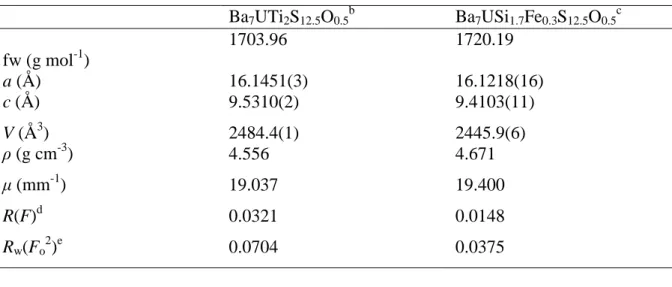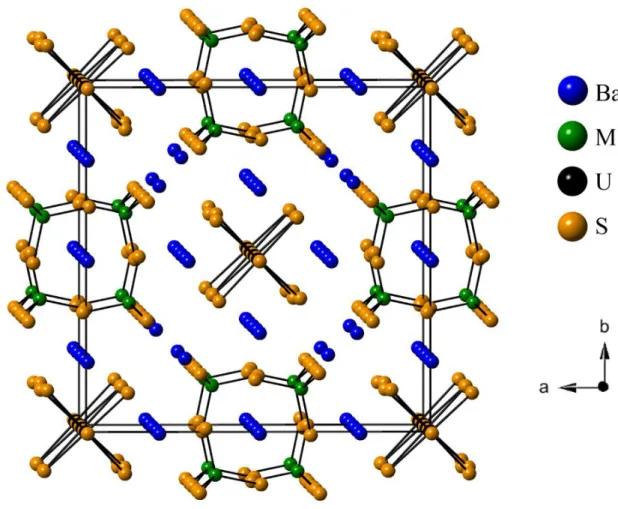HAL Id: hal-02349662
https://hal.umontpellier.fr/hal-02349662
Submitted on 14 Nov 2020HAL is a multi-disciplinary open access archive for the deposit and dissemination of sci-entific research documents, whether they are pub-lished or not. The documents may come from teaching and research institutions in France or abroad, or from public or private research centers.
L’archive ouverte pluridisciplinaire HAL, est destinée au dépôt et à la diffusion de documents scientifiques de niveau recherche, publiés ou non, émanant des établissements d’enseignement et de recherche français ou étrangers, des laboratoires publics ou privés.
Syntheses and crystal structures of the
Ba7UM2S12.5O0.5 (M = Ti, Si/Fe) compounds
Adel Mesbah, Jai Prakash, Jessica Beard, Christos Malliakas, James Ibers
To cite this version:
Adel Mesbah, Jai Prakash, Jessica Beard, Christos Malliakas, James Ibers. Syntheses and crystal structures of the Ba7UM2S12.5O0.5 (M = Ti, Si/Fe) compounds. Materials Letters, Elsevier, 2019, 252, pp.293-295. �10.1016/j.matlet.2019.05.092�. �hal-02349662�
1
Syntheses and crystal structures of the Ba7UM2S12.5O0.5 (M = Ti, Si/Fe) compounds
Adel Mesbah,a,b Jai Prakash,a,c Jessica C. Beard,a Christos. D. Malliakas,a and James A. Ibersa,*
aDepartment of Chemistry, Northwestern University, 2145 Sheridan Road, Evanston, IL 60208-3113, United States.
b
ICSM, UMR 5257 CEA, CNRS, ENSCM, Univ Montpellier, Site de Marcoule - Bât. 426, BP 17171, 30207 Bagnols-sur-Cèze, France.
c
Department of Chemistry, Indian Institute of Technology Hyderabad, Kandi 502 285, Sangareddy, Telangana, India.
Abstract
Black single crystals of the Ba7UM2S12.5O0.5 (M = Ti, Si/Fe) compounds were obtained by standard
solid-state chemistry method at 1123 K. Both compounds crystallize at 100 K in the Ba7UV2S12.5O0.5
structure type in space group I4/mcm of the tetragonal system with a = 16.1451(3) Å and c = 9.5310(2) Å (Ba7UTi2S12.5O0.5) and a = 16.1218(16) Å and c = 9.4103(11) Å (Ba7USi1.7Fe0.3S12.5O0.5).
The crystal structures consist of infinite chains of U atoms octahedrally coordinated through the sharing of O/S corners along the c axis. The M atoms form isolated MS4 tetrahedra aligned also along
the c axis. The space between US5O and MS4 polyhedra is filled by Ba atoms.
Keywords:
- Solid state chemistry; Crystal structure; X-ray techniques; Ba7UV2S12.5O0.5 structure type
*
Corresponding author.
1. Introduction.
Actinide chalcogenides (An =Th, U, Np; Q =S, Se, Te) form the basis for the study of interactions between the actinides (5f) and transition metals (3d). Although such An systems are well studied, those with Ak (Ak = alkaline-earth metal) are not. Examples of the latter were reported in a recent review [1]. Among them, the compounds Ba7UM2S12.5O0.5 (M = Fe, V) [2] are particularly relevant to the present study. These show remarkable flexibility that allows the accommodation of two transition metals having different oxidation states in the structure. In fact V4+ atoms are positioned in isolated VS4 tetrahedra in the V compound, but in the Fe compound a short S−S bond leads to the formation of a Fe2S8 species and charge balance of the compound. The V compound crystallizes in space group I4/mcm, whereas the Fe compound crystallizes in space group P4/mbm of the tetragonal system. Here we describe the syntheses and structural characterization of the two new compounds, Ba7UTi2S12.5O0.5 and Ba7USi1.7Fe0.3S12.5O0.5. Both crystallize in space group I4/mcm in the Ba7UV2S12.5O0.5 structure type.
2. Experimental section
2.1 Syntheses
The starting reactants were used as supplied: Ba (Johnson Matthey, 99.5%), S (Mallinckrodt, 99.6%), Ti (Aldrich, 99.7%), and Si (Aldrich, 99.99 %). Depleted U chips (IBI laboratories) were powdered by hydridization in a modification [3] of a previous literature protocol [4].
For each reaction, the weighed amounts of powders were loaded into a carbon-coated fused-silica 6 mm tube inside an Ar-filled dry box. The tube had been pre-baked and dried at 500 K. The tube was transferred with a special adapter to minimize oxygen or moisture contamination, then evacuated to 10-4 Torr, and flame sealed. Finally the tube was placed in a computer-controlled furnace, heated to 1123 K in 48 h, held at that temperature for 96 h, then cooled to 673 K at 2.5 K/h before the furnace was turned off. Some crystals were selected and analyzed with an EDX-equipped Hitachi S-3400 SEM.
3
Ba7UTi2S12.5O0.5. Black blocks of Ba7UTi2S12.5O0.5 were obtained (yield 70%) in an attempt to synthesize the eventual quaternary compound Ba3TiUS6 that crystallizes as a 2H hexagonal perovskite [5]. Therefore, the mixture consisted of U (20.23 mg, 0.084 mmol), Ti (14.00 mg, 0.255 mmol), Ba (35.01 mg, 0.255 mmol), and S (16.35 mg, 0.51 mmol). EDX analysis on black crystals revealed a molar ratio close to Ba:Ti:U:S ≈UOS [6] was detected as a byproduct. Other attempts were performed that led to the formation of a black powder.
Ba7USi1.7Fe0.3S12.5O0.5. This compound was obtained (yield 70%) in an attempt to
synthesize the Ba7USi2S12.5O0.5 compounds. The reaction mixture consisted of U (20 mg, 0.084 mmol), Ba (81.69 mg, 0.59 mmol), Si (4.76, 0.16 mmol), and S (35.43 mg, 1.11 mmol). Black blocks were analyzed by EDX to reveal Ba:U:Si:Fe:S ≈The presence of Fe is probably a contamination from an earlier reaction that led to another compound (Ba8UFeSiS14 [7]). A secondary phase was also detected with a U:S ratio of 1:1 and considered as UOS [6].
2.2 Structure determinations
Single-crystal X-ray diffraction data for the compounds Ba7UTi2S12.5O0.5 and Ba7USi1.7Fe0.3S12.5O0.5 were collected at 100(2) K with the use of the Bruker APEX2 diffractometer equipped with graphite-monochromatized MoKα radiation (λ = 0.71073 Å) [8]. The data collection strategy used the algorithm COSMO implemented in the APEX2 package with a series of 0.3 scans in ω and φ. The exposure time was 10 s/frame. The collection of intensity data as well as cell refinement and data reduction were carried out with the use of the program APEX2 [8]. Face-indexed absorption, incident beam, and decay corrections were performed with the use of the program SADABS [9]. Both structures were solved and refined with the use of the SHELX14 programs [10]. As found previously, both structures contain oxygen; the O atoms were refined successfully. In addition the crystal structure of Ba7USi1.7Fe0.3S12.5O0.5 was refined with Fe and Si occupying the same positions and having the same displacement parameters. Additional information is given in Table 1 and in Supplementary Material.
3. Results and discussion
3.1 Structure of Ba7UM2S12.5O0.5
The compounds Ba7UTi2S12.5O0.5 and Ba7USi1.7Fe0.3S12.5O0.5 crystallize in the Ba7UV2S12.5O0.5 [2] structure type in space group I4/mcm of the tetragonal system with four formula units in unit cells of dimensions a = 16.1451(3) Å and c = 9.5310(2) Å and a = 16.1218(16) Å and c = 9.4103(11) Å at 100 K, respectively. The asymmetric unit contains one disordered U1 atom (site symmetry 4..), one M (Ti or (0.85 Si + 0.15 Fe)) atom (m.2m), three Ba atoms Ba1, Ba2, Ba3 (.2., m.2m,−42m, respectively), three S positions S1, S2, S3 (..m, m.., and m.., respectively), and also an O1/S4 mixed site (422). A general drawing of the structure is viewed in Fig. 1 along the c axis; metrical values are reported in Table 2. Each U atom is octahedrally coordinated to five S atoms and one O atom. These octahedra are connected through the sharing of O/S corners along the c axis to form infinite chains, as viewed in Fig. 2. The presence of the -U-S-U-O- sequence leads to a 50% disorder of the U atoms along the c direction (Fig. 2). The Ti or (Si/Fe) site is coordinated to four S atoms to form isolated tetrahedra aligned along the c axis. The space between US5O infinite chains and isolated MS4 tetrahedra is filled by Ba atoms leading to the one-dimensional structure.
The U−S distances are 2.648(1) Å and 2.667(2) Å (Ba7UTi2S12.5O0.5) and 2.604(1) Å and 2.690(1) Å (Ba7USi1.7Fe0.3S12.5O0.5). Similar U−S distances occur (2.627(1) Å and 2.679(1) Å) for Ba7V2US12.5O0.5 and 2.596(1)−2.667(2) Å (U1), 2.598(1)−2.640(2) Å (U2) for Ba7UFe2S12.5O0.5 [2]. Compare these distances with those of BaUS3 [11] 2.668(1) to 2.696(1) Å, Ba2Cu2US5 [12] 2.673(2) to 2.770(1) Å, and Li2US3 [13] 2.603 to 2.677 Å.
The U1−O distances are 2.118(1) Å and 2.101(1) Å for Ba7UTi2S12.5O0.5 and Ba7USi1.7Fe0.3S12.5O0.5, respectively. In UP4O12 distance is 2.136(1) Å [14]. In Ba7UTi2S12.5O0.5 the Ti−S distances are 2.177(3) Å and 2.190(3) Å; these are 2.24(2) and 2.29(1) in Tl4TiS4 [15]. In Ba7USi1.7Fe0.3S12.5O0.5 the Si/Fe distances are 2.111(1) Å and 2.139(1) Å. The Si−S distances in Ba8USi2S14 are 2.105(3)−2.127(2) Å and the Fe−S distances in Ba8USiFeS14 are 2.154(1)−2.182 (1) Å [7].
The bond angles reported in Table 2 are typical for a US5O octahedra and MS4 tetrahedra. The Ba1 and Ba2 atoms are coordinated to eight S atoms whereas each Ba3 atom is nine coordinated. Those values are reported in Table 2 and may be compared with those
5 found in similar compounds, such as BaUS3 [11], Ba2US6 [16], Ba3.69US6 [11], and BaU2S5 [11].
3.2 Oxidation states
Because there are no short S−S distances, the assignment of formal oxidation states in the Ba7UTi2S12.5O0.5 compound is straightforward with 7 Ba2+, 2 Ti4+, 1 U4+, 12.5 S2−, 0.5 O2−. In the Ba7USi1.7Fe0.3S12.5O0.5 the assumption of Fe3+ with 7 Ba2+, 1.7 Si4+, 12.5 S2−, 0.5 O2−, leads to a mixed charge balance of U4/5+. U4/5+ has previously been conjectured in the compounds Ba3.69US6 [11], Ba3.3Rb0.7US6 [17], and Ba3.2K0.8US6 [17].
4. Conclusions
The Ba7UM2S12.5O0.5 (M = Ti, Si/Fe) compounds crystallize in Ba7V2US12.5O0.5 structure type in space group I4/mcm of the tetragonal system. The crystal structure consists of US5O octahedra connected through the sharing of S/O corners to form infinite chains and isolated MS4 tetrahedra, both aligned down the c axis. Ba atoms fill the space between US5O and MS4 polyhedra. Conflict of Interest None Declaration of Interest None Acknowledgments
Use was made of the IMSERC X-ray Facility at Northwestern University, which has received support from the Soft and Hybrid Nanotechnology Experimental (SHyNE) Resource (NSF ECCS-1542205); the State of Illinois, and International Institute for Nanotechnology (IIN).
Appendix. Supplementary data
Data for Ba7UTi2S12.5O0.5 (CCDC#1898481) and Ba7USi1.7Fe0.3S12.5O0.5 (CCDC#1898480) may be obtained free of charge by contacting CCDC at (https://www.ccdc.cam.ac.uk).
References
[2] J. Prakash, M.S. Tarasenko, A. Mesbah, S. Lebègue, C.D. Malliakas, J.A. Ibers, Inorg. Chem. 53 (2014) 11626-11632.
[3] D.E. Bugaris, J.A. Ibers, J. Solid State Chem. 181 (2008) 3189-3193. [4] A.J.K. Haneveld, F. Jellinek, J. Less-Common Met. 18 (1969) 123-129.
[5] A. Mesbah, C.D. Malliakas, S. Lebègue, A.A. Sarjeant, W. Stojko, L.A. Koscielski, J.A. Ibers, Inorg. Chem. 53 (2014) 2899-2903.
[6] N. Sato, H. Masuda, M. Wakeshima, K. Yamada, T. Fujino, J. Alloys Compd. 265 (1998) 115-120.
[7] A. Mesbah, J. Prakash, S. Lebègue, W. Stojko, J.A. Ibers, Solid State Sci. 48 (2015) 120-124.
[8] Bruker APEX2 Version 2009.5-1 Data Collection and Processing Software,, Bruker Analytical X-Ray Instruments, Inc., Madison, WI, USA, 2009.
[9] Bruker SMART Version 5.054 Data Collection and SAINT-Plus Version 6.45a Data Processing Software for the SMART System, Bruker Analytical X-Ray Instruments, Inc., Madison, WI, USA, 2003.
[10] G.M. Sheldrick, Acta Crystallogr. Sect. A: Found. Crystallogr. 64 (2008) 112-122. [11] A. Mesbah, J.A. Ibers, J. Solid State Chem. 199 (2013) 253-257.
[12] H.-yi Zeng, J. Yao, J.A. Ibers, J. Solid State Chem. 181 (2008) 552-555.
[13] H. Masuda, T. Fujino, N. Sato, K. Yamada, M. Wakeshima, J. Alloys Compd. 284 (1999) 117-123.
[14] S.A. Linde, Y.E. Gorbunova, A.V. Lavrov, Zh. Neorg. Khim. 28 (1983) 1391-1395. [15] K.O. Klepp, G. Eulenberger, Z. Naturforsch. B: Anorg. Chem. Org. Chem. 39 (1984)
705-712.
[16] A. Mesbah, E. Ringe, S. Lebègue, R.P. Van Duyne, J.A. Ibers, Inorg. Chem. 51 (2012) 13390-13395.
[17] A. Mesbah, J. Prakash, J.C. Beard, E.A. Pozzi, M.S. Tarasenko, S. Lebegue, C.D. Malliakas, R.P. Van Duyne, J.A. Ibers, Inorg. Chem. 54 (2015) 2851-2857.
7
Table 1. Crystal data and structure refinements for Ba7UTi2S12.5O0.5 and
Ba7USi1.7Fe0.3S12.5O0.5a Ba7UTi2S12.5O0.5b Ba7USi1.7Fe0.3S12.5O0.5c fw (g mol-1) 1703.96 1720.19 a (Å) 16.1451(3) 16.1218(16) c (Å) 9.5310(2) 9.4103(11) V (Å3) 2484.4(1) 2445.9(6) ρ (g cm-3 ) 4.556 4.671 μ (mm-1 ) 19.037 19.400 R(F)d 0.0321 0.0148 Rw(Fo2)e 0.0704 0.0375 a
Space group = I4/mcm, T = 100(2) K, Z = 4, λ = 0.71073 Å.
b CCDC#1898481 c CCDC#1898480 dR(F) = Σ ││ Fo − Fc ││ / Σ │ Fo │ for Fo2 > 2σ(Fo2). e Rw(Fo2) = {Σ w(Fo2 − Fc2)2 / ΣwFo4}1/2. For Fo2 < 0, w−1 = σ2(Fo2); for Fo2 ≥ 0, w−1 = σ2(Fo2) + (qFo2)2 where q = 0.0178 for Ba7UTi2S12.5O0.5, 0.0091 for Ba7USi1.7Fe0.3S12.5O0.5
Table 2 Selected Interatomic Distances (Å) and bond angles (deg) for Ba7UTi2S12.5O0.5 and Ba7UTi1.7Fe0.3S12.5O0.5. Ba7UTi2S12.5O0.5 Ba7UTi1.7Fe0.3S12.5O0.5 U1−S4 × 4 2.667(2) 2.690(1) U1−S1 2.648(1) 2.604(1) U1−O1 2.118(1) 2.101(1) M1−S2 × 2 2.177(3) 2.111(1) M1−S3 × 2 2.190(3) 2.139(1) Ba1−S 3.032(2)−3.421(2) 3.027(1)−3.502(1) Ba2−S3 × 8 3.436(2) 3.378(1) Ba3−S 3.262(2)−3.461(2) 3.2628(7)−3.441(1) S1−U1−S1 180.0 180.0 S1−U1−S4 95.71(2) 95.37(1) S2−Si1−S2 116.29(17) 117.57(7) S2−Si1−S3 106.67(4) 107.05(1) S3−Si1−S3 114.14(17) 111.08(8)
Figure 2:
Fig 2: The alignment of the US5O octahedra to form the infinite linear chains in the Ba7UM2S12.5O0.5 compounds.


